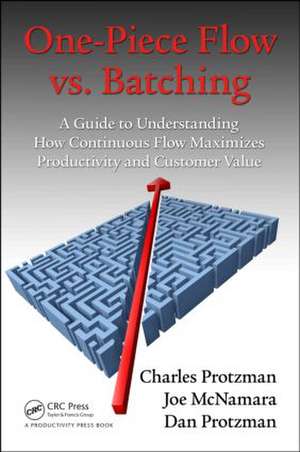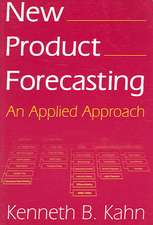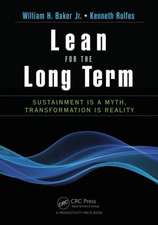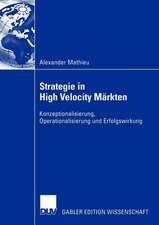One-Piece Flow vs. Batching: A Guide to Understanding How Continuous Flow Maximizes Productivity and Customer Value
Autor Charles Protzmanen Limba Engleză Paperback – 12 noi 2015
This book argues the case for one-piece flow over batching. It identifies the eight root causes of batching, the wastes created from batching, how batching drives the eight wastes, and the advantages of one-piece flow.
One-Piece Flow vs. Batching: A Guide to Understanding How Continuous Flow Maximizes Productivity and Customer Value provides concrete arguments as to why batching, while sometimes necessary, is never the most efficient solution for most processes. It explains why flow, especially one-piece flow or continuous flow, should always be your ultimate objective when driving for increased productivity in any process.
Using case studies to illustrate how to channel current mindsets toward one-piece flow as the preferred operation, the book is designed to support anyone involved in continuous improvement activities. It provides the tools and understanding you will need to overcome resistance to implementing flow and, in particular, one-piece flow processes—whether it be on the factory floor or in a banking office.
Preț: 239.68 lei
Preț vechi: 288.05 lei
-17% Nou
Puncte Express: 360
Preț estimativ în valută:
45.87€ • 47.71$ • 37.87£
45.87€ • 47.71$ • 37.87£
Carte tipărită la comandă
Livrare economică 14-28 aprilie
Preluare comenzi: 021 569.72.76
Specificații
ISBN-13: 9781498726948
ISBN-10: 1498726941
Pagini: 257
Ilustrații: 75 black & white illustrations, 4 black & white tables
Dimensiuni: 156 x 234 x 15 mm
Greutate: 0.38 kg
Ediția:1
Editura: Taylor & Francis
Colecția Productivity Press
Locul publicării:Oxford, United Kingdom
ISBN-10: 1498726941
Pagini: 257
Ilustrații: 75 black & white illustrations, 4 black & white tables
Dimensiuni: 156 x 234 x 15 mm
Greutate: 0.38 kg
Ediția:1
Editura: Taylor & Francis
Colecția Productivity Press
Locul publicării:Oxford, United Kingdom
Public țintă
Professional Practice & DevelopmentCuprins
The Silent Productivity Killer. Who Batches … and What’s the Big Deal If It’s Me? Types of Batching. A Few More Examples. Let’s Get into This a Little Deeper. The Eight Root Causes of Batching. The Eight Root Causes of Batching Continued. What Problems Come with the Batching Paradox? Light Shined on the Hidden Costs of Batching. Which Came First, Batching or the Eight Wastes? Debunking the Myths. Batching vs. One-Piece Flow. Are You Ready for One-Piece Flow? Appendix. Index.
Recenzii
"I highly recommend One-Piece Flow vs Batching by Charlie Protzman, Joe McNamara, and Dan Protzman. ... The authors have put together a series of real life examples of one-piece flow vs batching that really highlight the waste that drives batching.
—Kenneth L. Skiles, Director, Continuous Improvement, Lincoln Electric
"I do recommend that you carefully study this book and recognize that batching must disappear to achieve one-piece flow if you want to compete in the world arena."
Norman Bodek, Owner, PCS Press
"This is the first book I have read that comprehensively confronts the ills of batching in a single volume and provides an alternative. It does so in language that is clear and accessible to all levels in an organization—from CEO to middle managers to workers on the shop floor! A great contribution to the ‘improving productivity’ agenda. Read it!"
—Augustus J. Lusack MSc, MBA, Lean Six Sigma Black Belt; Founder: ‘Why Not?’ Solutions Limited; Head of Pathology, Northampton General Hospital, UK
"This book is relevant to both newer students of Lean as well as seasoned Lean practitioners looking to gain an insightful understanding of a cause of much waste in our organizations, BATCHING. By presenting numerous examples from many different industries, readers will finish the book appropriately armed to first identify and then eliminate batching."
—Kenneth W. Place, Lean Six Sigma Master Black Belt, University of Illinois BIS
"I am a batch-person. Whenever there is a chance to batch I have a certain tendency to do so. Charles Protzman’s book made me reconsider this position. I think this is the best one can say about any book. As a ‘good’ scientist I do not agree in all points; but I consider the arguments brought forward for one-piece flow convincing. It is not a dull repetition of you ‘should not batch’ but reasonable arguments against batching are developed. While this sounds not very exciting, practical examples and great writing style make it a very enjoyable read. In short - the authors successfully continue Ohno’s quest towards one-piece flow."
—Matthias Thürer, Professor, Jinan University, China
"I have spent 38 years in the steel industry in quality assurance, process control, and operations management and have been successful by finding ways to optimize performance by taking advantage of new technology, understanding and controlling process variation, and looking for opportunities to get more for less. Like the plant manager that Charlie dedicated this book to though, I have to admit that I still believe that in some industries there is cost savings to be had by increasing batch size. I would be the last guy to tell you that it might be efficient to make a heat of steel for each casting that you are producing. But I will admit the book makes you think about what the savings that could be possible if that was technically possible.
Charlie uses an example in the book of having to wait until you fill up the dishwasher and run the cycle before you get a clean plate. He challenges you to imagine if there was a dishwasher that does one place setting at a time. What a dumb idea, right? I was just in an innovation class where it was discussed that Whirlpool has been working on just such a device, but has not yet overcome the resistance to the cost of retrofitting it into current households. Their new strategy is to work with builders of new homes. Maybe not such a bad idea after all. If we stick to our old paradigms we may never see the opportunity to try something different.
Remember there are three stages to implementing change. The first stage is total resistance. When the idea first comes up it is always a really dumb idea. Giving up on economies of scale and our very nature to complete one task on all parts before moving on? After enjoying an easy read with some great examples and taking advantage of the workshop activities that Charlie has presented, you might make it to stage two in the change process; "hey this stuff may actually work". When you actually implement one piece flow and watch your inventories disappear, your quality improve, and your costs decrease, you will have made it to stage 3 in the change process."
—Jon Schumacher, Chief Operating Officer Wheel, Amsted Rail
"This is a must-read for everyone striving for Lean excellence! I guarantee that you will gain an awareness and a new perspective on some traditional processing practices. You will be motivated to accelerate your efforts in dismantling these wasteful batching methods and replacing them with the significantly more effective one-piece flow approach. Lean success is dependent on changing traditional mindsets and the author persuasively addresses one of our most entrenched mindsets, that of batch processing. The author opens the reader's eyes to the waste creating batching practices which occur not only at our workplace, but in our daily lives outside of the workplace as well. You'll find yourself scratching your head more than once and saying to yourself, ‘He's right, I do that without even thinking about it. What am I doing!’ The author then provides the remedy to this batching addiction, one-piece flow. He delves into the multiple root causes of why we batch, so the reader can begin to develop productive countermeasures. The many advantages of one-piece flow are clearly demonstrated throughout the book. One-piece flow processing is one of the most difficult aspects of Lean since we somehow seem to be hard-wired to batch, so I'm really glad that this book was finally written to help every single person ‘get it.’ To get why one-piece flow is the only way to go. Please read this book!"
—David Rizzardo, Associate Director, The Maryland World Class Consortia
—Kenneth L. Skiles, Director, Continuous Improvement, Lincoln Electric
"I do recommend that you carefully study this book and recognize that batching must disappear to achieve one-piece flow if you want to compete in the world arena."
Norman Bodek, Owner, PCS Press
"This is the first book I have read that comprehensively confronts the ills of batching in a single volume and provides an alternative. It does so in language that is clear and accessible to all levels in an organization—from CEO to middle managers to workers on the shop floor! A great contribution to the ‘improving productivity’ agenda. Read it!"
—Augustus J. Lusack MSc, MBA, Lean Six Sigma Black Belt; Founder: ‘Why Not?’ Solutions Limited; Head of Pathology, Northampton General Hospital, UK
"This book is relevant to both newer students of Lean as well as seasoned Lean practitioners looking to gain an insightful understanding of a cause of much waste in our organizations, BATCHING. By presenting numerous examples from many different industries, readers will finish the book appropriately armed to first identify and then eliminate batching."
—Kenneth W. Place, Lean Six Sigma Master Black Belt, University of Illinois BIS
"I am a batch-person. Whenever there is a chance to batch I have a certain tendency to do so. Charles Protzman’s book made me reconsider this position. I think this is the best one can say about any book. As a ‘good’ scientist I do not agree in all points; but I consider the arguments brought forward for one-piece flow convincing. It is not a dull repetition of you ‘should not batch’ but reasonable arguments against batching are developed. While this sounds not very exciting, practical examples and great writing style make it a very enjoyable read. In short - the authors successfully continue Ohno’s quest towards one-piece flow."
—Matthias Thürer, Professor, Jinan University, China
"I have spent 38 years in the steel industry in quality assurance, process control, and operations management and have been successful by finding ways to optimize performance by taking advantage of new technology, understanding and controlling process variation, and looking for opportunities to get more for less. Like the plant manager that Charlie dedicated this book to though, I have to admit that I still believe that in some industries there is cost savings to be had by increasing batch size. I would be the last guy to tell you that it might be efficient to make a heat of steel for each casting that you are producing. But I will admit the book makes you think about what the savings that could be possible if that was technically possible.
Charlie uses an example in the book of having to wait until you fill up the dishwasher and run the cycle before you get a clean plate. He challenges you to imagine if there was a dishwasher that does one place setting at a time. What a dumb idea, right? I was just in an innovation class where it was discussed that Whirlpool has been working on just such a device, but has not yet overcome the resistance to the cost of retrofitting it into current households. Their new strategy is to work with builders of new homes. Maybe not such a bad idea after all. If we stick to our old paradigms we may never see the opportunity to try something different.
Remember there are three stages to implementing change. The first stage is total resistance. When the idea first comes up it is always a really dumb idea. Giving up on economies of scale and our very nature to complete one task on all parts before moving on? After enjoying an easy read with some great examples and taking advantage of the workshop activities that Charlie has presented, you might make it to stage two in the change process; "hey this stuff may actually work". When you actually implement one piece flow and watch your inventories disappear, your quality improve, and your costs decrease, you will have made it to stage 3 in the change process."
—Jon Schumacher, Chief Operating Officer Wheel, Amsted Rail
"This is a must-read for everyone striving for Lean excellence! I guarantee that you will gain an awareness and a new perspective on some traditional processing practices. You will be motivated to accelerate your efforts in dismantling these wasteful batching methods and replacing them with the significantly more effective one-piece flow approach. Lean success is dependent on changing traditional mindsets and the author persuasively addresses one of our most entrenched mindsets, that of batch processing. The author opens the reader's eyes to the waste creating batching practices which occur not only at our workplace, but in our daily lives outside of the workplace as well. You'll find yourself scratching your head more than once and saying to yourself, ‘He's right, I do that without even thinking about it. What am I doing!’ The author then provides the remedy to this batching addiction, one-piece flow. He delves into the multiple root causes of why we batch, so the reader can begin to develop productive countermeasures. The many advantages of one-piece flow are clearly demonstrated throughout the book. One-piece flow processing is one of the most difficult aspects of Lean since we somehow seem to be hard-wired to batch, so I'm really glad that this book was finally written to help every single person ‘get it.’ To get why one-piece flow is the only way to go. Please read this book!"
—David Rizzardo, Associate Director, The Maryland World Class Consortia
Notă biografică
Charles Protzman, Joe McNamara, Dan Protzman
Descriere
A silent productivity killer, batching is an extremely difficult mindset to overcome and, as a result, numerous Lean initiatives have been destroyed by it. This book argues the case for one piece flow over batching. It identifies the eight root causes of batching, the wastes created from batching, how batching drives the eight wastes, and the advantages of one piece flow. The book provides concrete arguments as to why batching is usually not the most efficient solution for most processes.















